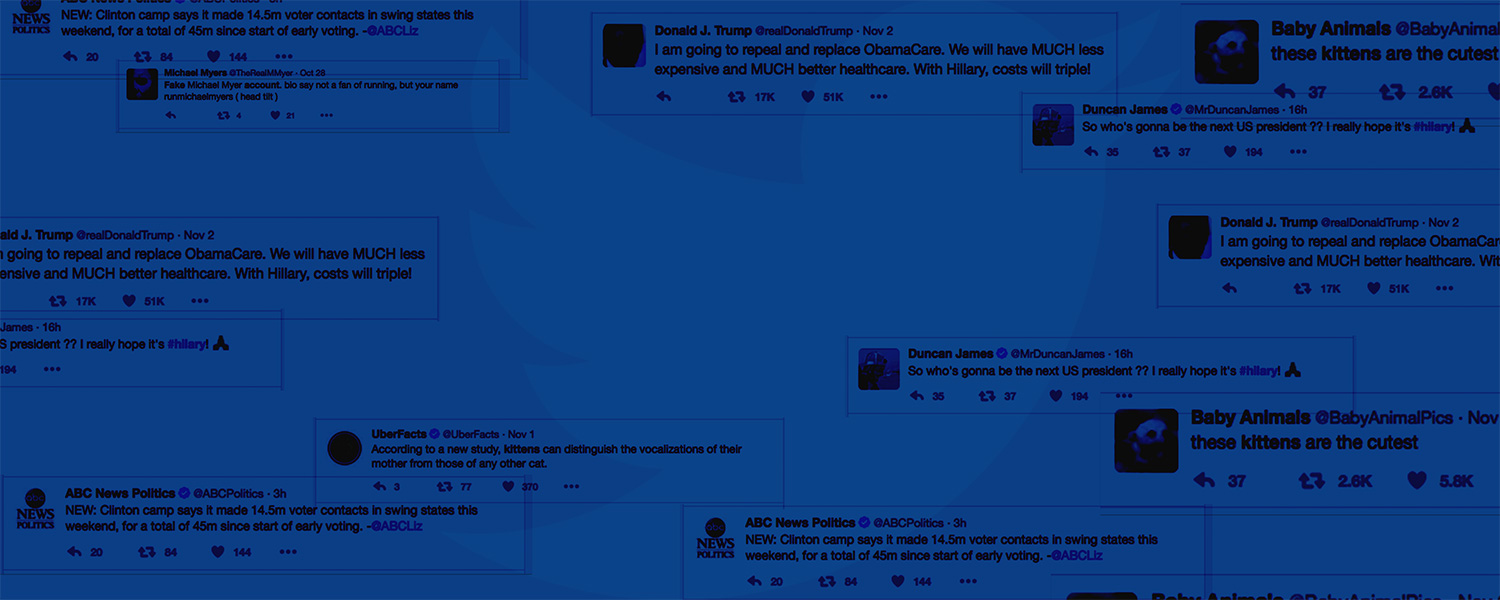Social media has been an essential battleground in the 2016 presidential election, with Twitter at the forefront. The site is almost constantly in the news as both candidates use it as an additional platform for debate and outreach.
Kevin Driscoll, an assistant professor of media studies at the University of Virginia, has been studying this phenomenon with students in his course, “Social Media and the General Election.”
Due to sheer amount of social media data available on the election, the class focused specifically on live-tweeting during the three presidential debates. Students learned to use Python programming language as a tool to extract and sort meaningful data from tweets sent during each debate. They also participated in viewing and posting to Twitter for each of the debates, and took notes on their own observations of the content.

Kevin Driscoll is an assistant professor of Media Studies. This semester, he teaches students to extract and analyze data from Twitter. (Photo by Dan Addison, University Communications)
“It’s primarily a qualitative research class, but we’re using the computer as a research assistant to draw our attention to things that would be impossible to see just by hand alone,” Driscoll said.
The students learned to design computer programs that would help them go beyond just obvious hashtag labels and extract meaningful metadata and subsets of users for comparison.
“For example, we could compare two groups of users: one who has verified accounts and 1,000 followers or more each, and another group of accounts who are not verified and have less than 1,000 followers each,” Driscoll said. “Then we ask, ‘Are they using similar language? How are they talking about the candidates? What’s similar? What’s different?’”
Prior to the debates, students spent the first weeks of the semester examining social media research published since the 2012 election. Using that theoretical foundation, they chose their own independent research topics and questions they wanted to address in studying the 2016 debates.
The chosen topics came together in several general research clusters: how Twitter users talk about the candidates’ appearance, how the speakers’ gender affected their engagement, how the campaigns and their surrogates make use of the channel, how Twitter is used to harass candidates and supporters, and how Twitter is used to circulate other sources of media.
For the question of how campaigns approach the platform, research shows that campaigns don’t just prep their candidates for debates. They’re also preparing to make supplemental materials available for the public as they watch.
“One thing we noticed during the debates was that both candidates – but especially the Clinton campaign – were ready, so they could say, ‘Well if you want to know more about this, you can go check my website or look on my Twitter feed or Facebook,” Driscoll said.
He explained that this made the debates a “central channel” for connecting streams of information over social media. Students analyzed how each campaign was using that stream, what kinds of supplemental materials they had ready and waiting, and how they reacted to some of the unscripted offers of additional information from the candidates.
While it’s still too early for students to draw final conclusions from their various areas of analysis – they’ll present final projects at the end of the semester – Driscoll said there are some general trends that emerged very clearly during the 2016 debate cycle.
One particularly troubling trend is the rise of fake accounts and what are called “AstroTurf accounts.”
“AstroTurf is a fake grassroots-looking account. You think that you’re seeing tweets from a typical American citizen, but it’s actually a profile that was created in order to recirculate partisan messages,” Driscoll said. “We knew that was happening to some extent in 2012, but since then, journalists and other researchers have discovered clear indisputable evidence that there is a cottage industry – mainly outside of the U.S. – which offers this as a service.”
Driscoll leaves it up to his students to decide how to interpret the role of these accounts in relation to their research, but he explained that their massive presence makes an undeniable impact on the overall dynamic of Twitter conversation. In many cases, fake accounts are the source of some of the most extreme partisan and vitriolic language found on the site.
Learning to spot these fakes and separate their impact from the impact of genuine Twitter user content is a good example of the overall purpose of the class – to discern the truth amid an ever-expanding hoard of information.
Many of Driscoll’s students aspire to be journalists, political analysts or even run for office themselves one day. Whatever their path, he wants them to learn to examine data critically and be able to spot when someone else is trying to manipulate it to present a certain view of the facts.
“I think media studies students are positioned at the borders of a lot of different ways of thinking about society and the role of media in society,” he said. “Getting these early experiences programming and extracting data is intended to let them lift the hood a little bit and see how the machinery works. A little bit of exposure to that allows you to think about how something like a timeline filter or an aggregate poll could work, whether or not you know exactly how it was set up.”
Driscoll will join UVA Today on Tuesday for a live conversation on our Facebook page, where he’ll “lift the hood” on Election Day Twitter trends for our readers. Join us at 1 p.m. to catch his analysis and send in your questions.
Media Contact
Article Information
November 7, 2016
/content/new-class-analyzes-campaign-16-through-eyes-twitter

